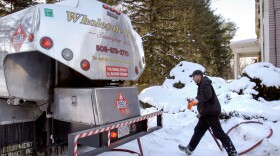A new report out this week shows that more Connecticut residents have become “Asset Limited, Income Constrained, Employed,” or ALICE, since the pandemic shutdown.
The estimates use the latest U.S. Census Bureau American Community Survey (ACS) data, which are from 2023. Nationwide, 40-45% of the country is living from paycheck to paycheck, or is one emergency away from financial crisis, according to the United Way.
Connecticut’s number is 40%, about 580,000 households. That’s several thousand more people compared to the year prior. Part of the challenge of these ALICE households having their needs met is that they don’t qualify for government subsidies.
“They don't get additional assistance because they earn above the federal poverty line, but they are far from secure,” said Shawonda Swain, president, United Way of Middlesex County. “They are often working multiple jobs, as you've heard, and still one unexpected bill can send them over the edge, and they're constantly on edge and they're fighting to stay afloat.”
Growing struggle for CT households
United Way said in about 10 years, 80,000 households have been added to that ALICE group.
The increased cost of living from 2022 to 2023 factored into the higher number of ALICE households, United Way said.
According to the report, 11% of Connecticut households were living at federal poverty levels, and 29% were ALICE homes. Of those, many were seniors and young adults. People who have pursued higher education, like Laly Rakotoniaina, said it comes with a high financial burden.
“Not because we are irresponsible, but because the cost of college, the living expenses are so high,” Rakotoniaina said.
Rakotoniaina said she had to move in with a friend when she was getting her degree because she couldn’t afford the $1,000 rent. Now a business teacher, she’s wondering if she will be able to pay down her $50,000 loan she got to go to college.
However the ALICE analysis is a conservative estimate – and report authors say there could be far more people struggling as the data does not include unhoused people, or those living in group houses such as college residence halls, skilled nursing facilities and military barracks.
Lawmakers ask: Can tax credits help?
Legislators like State Rep. Kate Farrar said one thing that could help struggling families is a permanent, refundable child tax credit, which she proposed last legislative session. The idea ultimately didn’t make it into the final budget. State lawmakers did approve an enhanced credit of $250 for families who already received the Earned Income Tax Credit (EITC).
“We know that Connecticut's struggling workers and their struggling families deserve our undivided attention,” Farrar, a Democrat representing West Hartford, said.“They're worried, they're stressed, they're overwhelmed, and they expect us to deliver for them. Today's ALICE report and the federal actions, they only make clear the urgency of this moment.”
Connecticut had a temporary child tax credit enacted amid the pandemic, but it ended in 2021.
Housing costs addressed
The report shows that 73% of all renter households below the ALICE threshold were rent burdened, meaning they pay nearly a third or more of their income on rent and utilities.
In 2021, that number was 69%.
“For decades, people think hardship has been mostly visible in our cities, right? But today, it's moving to our suburban and rural towns as well,” Swain said. “There are sharp increases in places like Chester and Lisbon in Eastern Connecticut and New Milford and Roxbury in the West. No corner of our state is untouched.”
Gov. Ned Lamont vetoed a sweeping housing bill earlier this year. Lawmakers have said they will bring it up in a special session this fall. Farrar said that would do a lot to help struggling residents.
“We can do all the things to address a lot of the cost of families, but when you look at the ALICE report and even the change between last year and this year, it's really some of the housing affordability issues that are front and center.”
Connecticut Public's Abigail Brone contributed to this report.





